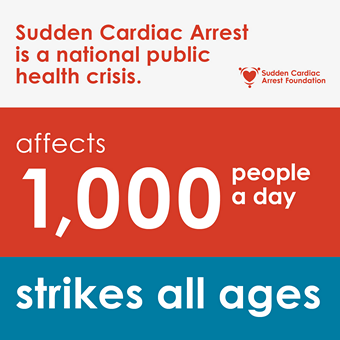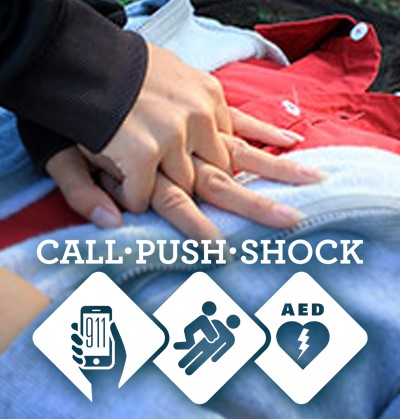 Sudden cardiac arrest remains a major public health crisis. Approximately 350,000 OHCA events occur annually in the U.S., with nearly 90% fatality1. Emergency Medical Services (EMS)-treated OHCA affects over 250,000 Americans each year2. Despite being a leading cause of death, there are currently no nationwide standards for surveillance of cardiac arrest incidence and outcomes. Registries and clinical trials such as the Resuscitation Outcomes Consortium (ROC, 2005–2015) and the ongoing CARES registry provide best estimates.
Sudden cardiac arrest remains a major public health crisis. Approximately 350,000 OHCA events occur annually in the U.S., with nearly 90% fatality1. Emergency Medical Services (EMS)-treated OHCA affects over 250,000 Americans each year2. Despite being a leading cause of death, there are currently no nationwide standards for surveillance of cardiac arrest incidence and outcomes. Registries and clinical trials such as the Resuscitation Outcomes Consortium (ROC, 2005–2015) and the ongoing CARES registry provide best estimates.
Out-of-Hospital Cardiac Arrest (OHCA) Incidence2
- In 2024, 137,119 OHCA events were reported to CARES.
- Estimated 263,711 EMS-treated, non-traumatic OHCA cases occurred in the U.S., based on census data extrapolation.
- The majority of patients were male (63.2%).
- Adults accounted for 97.3% (n=133,434) and children (≤18 years) for 2.7% (n=3,959).
Location of OHCA2
- Most OHCA events in adults occur at home or residence (about 71%).
- Public locations account for approximately 12–15%, with nursing homes and other locations making up the remainder.
Witnessed Status2
- Arrest witnessed by a layperson in 37.5% of cases.
- Witnessed by 911 responders in 12.3% of cases.
- Approximately 50.2% of arrests were unwitnessed. Witnessed status is crucial as it increases the likelihood of bystander intervention and timely care.
Pediatric OHCA
- In 2015, the American Heart Association estimated 7,037 EMS-assessed OHCA in children.3
- A 2023 Scientific Sessions from the American Heart Association shows that there were 1.74 million pediatric 9-1-1 calls in 2021, out of which 13,040 were OHCA events (7.6 per 1,000). Almost 58% of these calls involved male patients and the median age was 3 years (33% below age 1 and 30% aged 13–17).4
- More recent studies estimate pediatric OHCA incidence at 15,000 to 23,000 cases annually, representing about 15 per 1,000 pediatric EMS responses.5
- Pediatric OHCA survival remains around 10%, with complex resuscitation needs possibly contributing to lack of improvement.4
- In 2023, 15.9% of children 1 to 18 years of age with an OHCA treated by emergency medical services survived to hospital discharge.6
Sports-Related Sudden Cardiac Arrest (SCA) and Sudden Cardiac Death (SCD)
- Sports-related SCA accounted for 39% of SCAs among individuals ≤ 8 years old in Portland, OR (2002-2015).7
- Survival disparities exist by race, with white non-Hispanic/Latino athletes showing higher survival rates than Black/African American athletes.7
- In one study, if an athletic trainer was on-site and involved in the resuscitation effort, 83% of athletes survived. If an on-site AED was used, 89% survived.7
- A two-year study of young athletes between 2014-2016 (ages 11-27) identified 132 cases with an overall survival rate of 48%. Survival was higher when a certified athletic trainer and an on-site AED were involved (83% and 89%, respectively).8
- According to a 2023 Scientific Session from the American Heart Association, "sudden cardiac death (SCD) was the leading medical cause of death among NCAA athletes, comprising 13% of 1,102 total deaths, with male, Black, and Division 1 basketball players facing the highest risk; however, SCD incidence declined by 29% every 5 years over the 20-year study period, possibly due to improved CPR training, AED access, and emergency response planning.”9
Awareness and Treatment10
- One of the most critical interventions is early CPR. Bystander CPR was initiated in 41.7% of OHCA cases reported in CARES 2024, including 50.1% of witnessed cases.
- Survival to hospital discharge was higher for patients receiving bystander CPR (13.0%) versus those who did not (7.6%).
- States with high bystander CPR rates include Alaska (79.7%), Nevada (57.5%), Oregon (54.6%), Washington (53.6%).
- Laypeople were less likely to initiate CPR in low-income Black and predominantly Hispanic neighborhoods.
- States with higher bystander AED use include Nebraska (21.4%), Nevada (19%), Hawaii (18.2%), Pennsylvania (17.2%), and others.
OHCA Outcomes:
Adults:
- Median rates of survival to hospital discharge are poor (10.4%) and remain virtually unchanged for the past 30 years.11
- Regional survival is higher in the Midwest and South compared to the Northeast.11
- Neurologic recovery and survival are worse in White Hispanic, Black, and Asian patients than in White patients, partially due to delays in care and possible other vulnerabilities.12
Children:
- Survival to hospital discharge after EMS-treated non-traumatic OHCA was 13.2% in 2015 (ROC).13
- Survival rates vary by age: 6.5% for <1 year, 14.4% for 1-12 years, and 21.2% for 13-18 years (CARES 2020 data).14
- Pediatric OHCA shows significant racial and socioeconomic disparities in incidence and survival, in one study, black children had over 4x the incidence rate, and lower survival rates, compared to white children. Children from highest-risk neighborhoods have more than twice the incidence and lower survival rates compared to children from the lowest-risk neighborhoods.15
Sports-related SCA:
- Among athletes experiencing SCA during competitive sports, 43.8% survived to hospital discharge.16
Complications and Long-Term Outcomes
- Survivors often experience medical complications and report impaired consciousness, cognitive deficits, anxiety, depression, and posttraumatic stress disorder.17
- In a study of 287 people who survived hospitalization after OHCA, 47% had reduced participation in pre-OHCA activities, and 27% of those who were working before their arrest were on sick leave for six months.18
- A study on the psychological distress among surrogate caregivers conducted between 2021 to 2023, which included participation from 83 family members of cardiac arrest patients, showed high rates of distress: 66% reported anxiety, 29% showed PTSD traits, and 57% experienced moderate depression, with insights also gathered on preferred support resources.19
Compiled by Samya Madhukar & Gina Peattie, MPA, Sudden Cardiac Arrest Foundation
[1] American Heart Association, CPR Facts and Stats | American Heart Association CPR & First Aid; My Cares https://mycares.net/sitepages/aboutcares.jsp
[2] 2024 Annual Report. Cardiac Arrest Registry to Enhance Survival. 2024 CARES Annual Report
[3] American Heart Association 2022 Heart Disease & Stroke Statistical Update Fact Sheet Children & Cardiovascular Diseases
[4] American Heart Association Abstract 405: Characteristics and Care of Pediatric Out-of-Hospital Cardiac Arrest in the National Emergency Medical Services Information System | Circulation
[5] Pediatric OHCA incidence and outcomes. Comparison of Resuscitation Quality in Simulated Pediatric and Adult Out-of-Hospital Cardiac Arrest | Emergency Medicine | JAMA Network Open | JAMA Networ
[6] American Heart Association, 2025-stats-update-fact-sheet-children-and-cvd.pdf
[7] American Heart Association. Heart and Stroke Statistics – 2025 Update 2025 Heart Disease and Stroke Statistics: A Report of US and Global Data From the American Heart Association | Circulation
[8] Survival after Exercise-Related Sudden Cardiac Arrest in Young Athletes. PubMed Survival After Exercise-Related Sudden Cardiac Arrest in Young Athletes: Can We Do Better? - PMC
[9] American Heart Association, NCAA athletes’ sudden cardiac death rate fell over 20 years, still higher in some athletes |
[10] 2024 Annual Report. Cardiac Arrest Registry to Enhance Survival. 2024 CARES Annual Survival After Exercise-Related Sudden Cardiac Arrest in Young Athletes: Can We Do Better? - PMC
[11] About CARES « MyCares
[12] American Heart Association, Black, Hispanic cardiac arrest survivors often treated at hospitals with lower quality measures | American Heart Association
[13] American Heart Association 2022 Heart Disease & Stroke Statistical Update Fact Sheet Children & Cardiovascular Diseases; Resuscitation Outcomes Consortium (ROC), 2005–2015
[14] 2024 Annual Report. Cardiac Arrest Registry to Enhance Survival. 2024 CARES Annual Report
[15] Sociodemographic disparities in pediatric OHCA incidence and survival. Sociodemographic disparities in incidence and survival for pediatric out-of-hospital cardiac arrest in the United States - PubMed
[16] American Heart Association. Heart and Stroke Statistics – 2025 Update 2025 Heart Disease and Stroke Statistics: A Report of US and Global Data From the American Heart Association | Circulation
[17] American Heart Association Coping With Feelings | American Heart Association; Long Term Quality of Life After Out-of-Hospital Cardiac Arrest; American Heart Association Why a cardiac crisis also can be a mental health issue | American Heart Association
[18] American Heart Association, Return to Work and Participation in Society After Out-of-Hospital Cardiac Arrest. Return to Work and Participation in Society After Out-of-Hospital Cardiac Arrest | Circulation: Cardiovascular Quality and Outcomes
[19] American Heart Association After cardiac arrest, family members need support, too | American Heart Association
